Amplifier soft-starts
Designs with larger transformers may require soft-start circuits to prevent the mains fuse blowing on switch on, especially with toroidal types which use less copper wire (reducing winding impedance) and a high-grade core material. With no magnetic field established and discharged smoothers the fuse often sees a near short-circuit when an amp is turned on, and does it's job. For this reason a toroidal type's mains fuse will usually have a higher rating than that of an equivalent E-I type, which may not be desirable. For example, the Nakamichi PA-7 paralleled 4 x 6R8 10W resistors (each with it's own fuse) in series with the (700VA) primary, a relay then shorting these after a short delay. Alternatively, thermistors can be wired in series with the primary windings (eg: CL60 for domestic types).
Switch-on surges can be quite profound and can be major contributors to component failure. Reducing such surges can then prolong operating life. In-rush current limiters, similar to varistors, are available, but discrete solutions can be very effective. Although earlier designs, like that used in the BGW 750A can be employed, some other tested examples are given below (240V mains assumed);
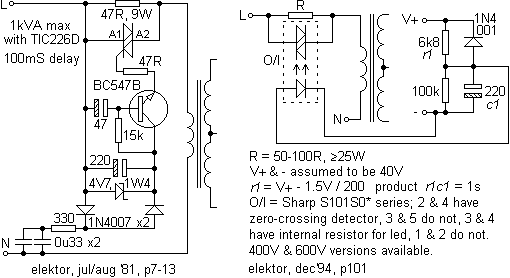
Triacs can cause problems by 'dropping-out' on low loads, say <100W. A TIC206D can suit loads of up to 50W, whilst a TIC226 will suit heavier ones. Noiseless (zero-voltage switching) power switches overcame this by shorting the triac with a pair of relay contacts 100mS or so after the triac was triggered, the sequence reversed on power-down. Since the 2V or so dropped across the triac dissipated little across the relay contacts, snubber networks were usually omitted.
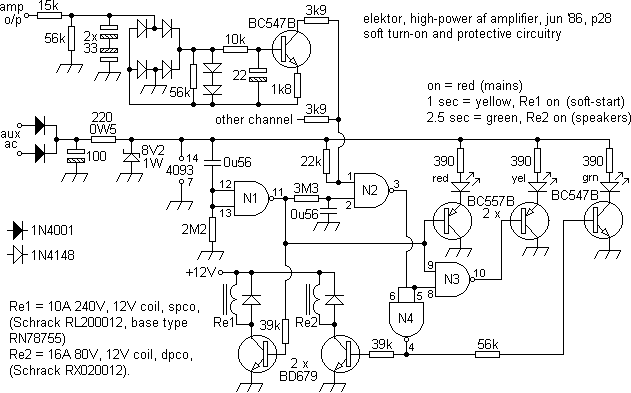
Intended for a 2 x 500W / 1 x 1kW amplifier, this circuit combines a soft-start, output DC protection and visual indication of condition. An auxillary supply gave ±12V for ancillary circuits and the 15-0-15V AC feed. Combining the amplifier inputs and speaker switching via a single circuit shuts down both channels when only one malfunctions.
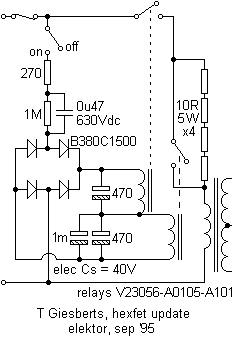
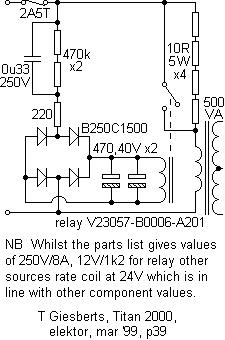
Two simpler arrangements, the Titan 2000 version for a 1kVA load, capable of switching 2kVA. For this, a separate more complex circuit provided DC protection, temperature sensing, visual indication and sequential switching of multiple (3) relays for the output and another shorting the amplifier input to ground.
In these kinds of circuits the potential across the relays can be used to drive opto-isolators or smaller relays that are then used to mute inputs.
A neat arrangement used the switched mains outlet of a preamp to trigger a single heavy-duty soft-start circuit. An array of power amps and associated equipment can thus be protected and powered up by a single switch, but ensure a manual by-pass exists, just in case. A standard 13A (UK) mains outlet equates with some 1½kW usable audio output (rms), and more with PWM.
To prevent a speaker being damaged as an output electrolytic charges through the load on switch-on, a simple supply arrangement will bring the supply up slowly allowing the cap to charge at a less precipitous rate. Allow an operating input/output differential of 5-6V. Additional benefits include hum filtering.
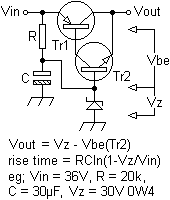
As an alternative, an output stage can be ramped to achieve the same result.
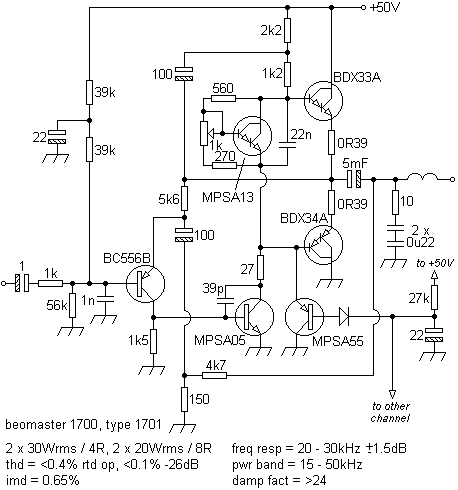
Another approach ramps the input pair and class A driver on power up.
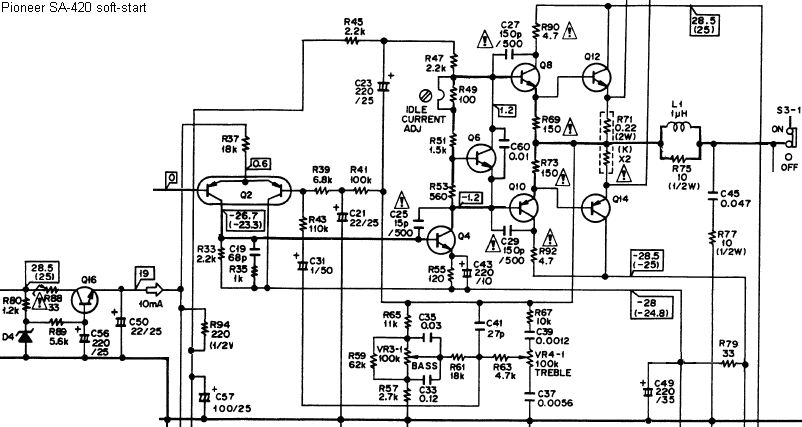
Sometimes long storage times can affect electrolytic capacitors adversely although a simple precaution can resolve this. The Al oxide layer may deteriorate when stored without an externally applied voltage, especially at higher temperatures. Since there is no leakage current to transport oxygen ions to the anode in this case, the oxide layer is not regenerated. The result is that a higher than normal leakage current will flow when a voltage is applied after prolonged storage. As the oxide layer is regenerated in use, however, the leakage current will gradually decrease to its normal level. Quality Al electrolytic capacitors can be stored voltage-free for at least 2 years, and long-life types for as long as 15 years without any loss of reliability. Provided that these storage periods have not been exceeded, the capacitors can be operated at rated voltage directly after being taken out of storage. In this case, reforming of the oxide layer is not required (this is normally achieved by running the capacitor in series with a 100R resistor for an hour). When designing application circuits, attention must be paid to the fact that the leakage current may be up to 100 times higher than normal during the first minutes following the application of power. When the capacitors have been stored for more than two years, it is decisive whether the circuit will tolerate high initial leakage currents. A circuit that has been stored for more than two years with the capacitors incorporated, should be operated trouble-free for one hour. This will usually regenerate the capacitors so far that storage can be continued. When applying power to a unit stored for some time, running it in series with a 60W light bulb for an hour or more can prevent failures.
Contact me at paulkemble@hotmail.com
especially if you want additional content to this page
or if you find
any links that don't work. Don't forget
to add the page title or URL. Take care!